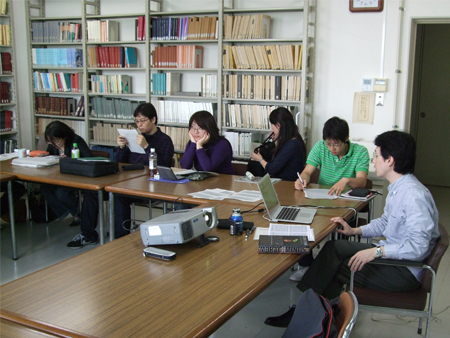UTCP Education Program "Brain Sciences and Ethics" Seminar 5, Session 1
In seminar 5 of the UTCP Education Program "Brain Sciences and Ethics", we examine Moral Minds by Marc D. Hauser. In session 1 of this seminar, we discussed Prologue & the first half of chapter 1 (pp. xvii-31).
Reported by Ryoji SATO (Fellow, UTCP)
In this semester, we are going to read Moral Minds by Marc D. Hauser. Hauser is a psychologist, and this book mainly focuses on the neuroscience of morality. Thus this book is not philosophical, but scientific. We read Jesse Prinz’s book last semester. He endorsed a Humean view of morality that emotions are crucial to it, and emphasized the influence of culture on morality. In contrast to him, Hauser claims that we have innate moral instincts and stresses the importance of both emotion and reason.

In the first half of chapter 1, Hauser introduced two opposing parties in ethics: Kantian and Humean. In the Kantian tradition, ethical judgments should be made by conscious reasoning process and these judgments must be universal. For instance, we must not lie regardless of circumstances, even if lying saves one’s life. On the other hand, in the Humean tradition, morality is like perception. What is good is what we feel good just as something red is what appears to us red. There is another important analogy between color and morality. Color on the surface of an object changes in accordance with lighting conditions. Likewise, a Humean insists what is good changes in accordance with contexts. For example, we ordinarily feel murder is wrong, but we do feel murder is permissible in the case that the victim was an armed robber and the offender was attacked by him/her.
Although Kantian and Humean positions are philosophical, not psychological, both have proponents in developmental psychology: Lawrence Kohlberg for Kant and Martin Hoffman for Hume. Kant himself did not talk about our real psychology of morality, thus labeling Kohlberg as a Kantian seems a little misleading. But Hauser’s intention to label Kohlberg as a Kantian only mentions the fact that Kohlberg regarded reasoning as central to our moral judgments. Hauser’s own position is eclectic; he did not endorse either Kant or Hume. In this book, he is going to propose a view that both reasoning and emotion play important roles in our moral psychology. He said, “Like all dichotomies, there are shades of gray. But for now, we can start with these two contrasting positions, using them to spring forward into a third” (p. 31).
When it turned out that a dichotomy does not hold, our initial contrasting concepts were also cast doubt on. These days, neuroscientists like Antonio Damasio and Antoine Bechara claim that emotion and reason are intimately related. They shake our understanding of them. I expect that Hauser brings us a radical re-evaluation of our concepts of reason and emotion.
I would like to mention another point which I will pay attention to in reading this book. Hauser admitted that his main aim of the book is to describe how morality is rather than how morality should be. Although these problems are prima facie different and traditional moral philosophers have largely neglected the descriptive dimension of morality, there seems a tension between them. I think normative ethics cannot neglect our real moral psychology. Perhaps, we need brain-friendly ethics. But I am not sure about what and how description of moral psychology should be taken into normative account.
Download PDF (38KB)
Presented by Kei YOSHIDA (Fellow, UTCP)
Download PDF (2.9MB)(Japanese)






